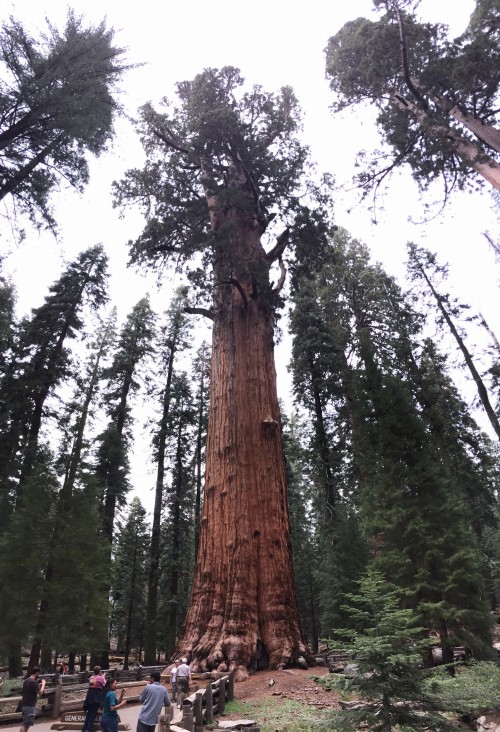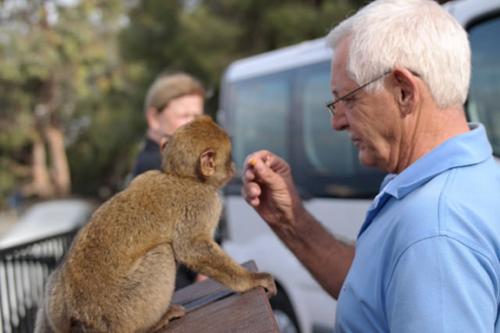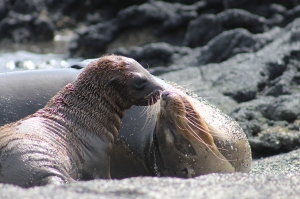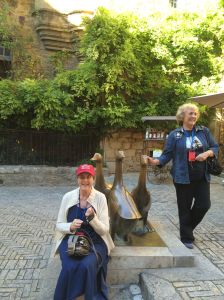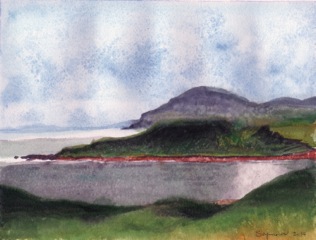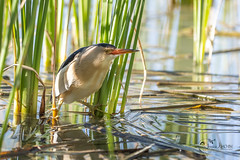Author: David Wallace, Judith Rodin Professor of English & Comparative Literature
Our group first convened at the Fairlawns Hotel, Sandton, Johannesburg, on Friday 6 February 2015. Most travellers had been met at Joburg airport by Tina Kistenmacher, representing Gohagan, our travel company. Tina proved to be a colossus of organizational finesse from the beginning to the end of our journey. Usually she rode herd at the back of the group, keeping a low profile, but if problems arose she would move to the front– and we would notice that she was athletic, very tall, and gently persuasive; she speaks four languages.
Our itinerary was rather complex, and we never slept in the same place for more than two nights. There were internal flights, and we crossed and re-crossed borders between South Africa, Botswana, Namibia, and Zimbabwe. This itinerary had never been tried before, although a Gohagan rep. had made a “dry run” to test things out. Everything worked amazingly well, and the group bonded right from the start. The group was small, with seven Penn alums, plus myself as current Penn Faculty, and smaller groups from the two USCs: Southern Cal, including environmentalist Roberto Delgado, and South Carolina. There were just sixteen of us in all, which was the perfect size for this particular adventure.
Our first full day saw us set off in the tracks of Nelson Mandela. We saw the house in Houghton where he lived with his third wife, Graca, and then the house where he died. Memorial stones had been left by people from all over the world:

We then headed towards Soweto, the locality in Johannesburg most famously associated with the struggle against apartheid. En route we passed five well-groomed pitches where the boys of St John’s School were playing cricket at 9.30 in the morning:

Progress through Soweto was slow, since funerals are held there only on Saturdays so that working people might attend. About 300 funerals take place every week, and many of the dead have succumbed to AIDS– still a critical health issue. Houses are generally small, with many children on the street, many of them orphans. Nonetheless, despite obvious hardships entrepreneurial spirit was clearly alive in Soweto, with makeshift spaces on the street for shoe repair and hair cutting:

First stop in Soweto was Vilakazi Street, reputedly the only street where one Nobel Prizewinner lived at one end (Desmond Tutu) and another at the other (Nelson Mandela). The modest house in which the Mandelas had lived, complete with bullet holes from opportunistic drive-by shooters, has become a shrine for African visitors, keen to record their visit:
We drove past the site, close by, where 13-year-old schoolboy Hector Pieterson had been shot by police on 16 June 1976, sparking mass protests, and we visited the museum dedicated to his memory. The image of the dying Hector being carried away, with his sister Antoinette at his side, rates as one of the most powerful, galvanizing photographs of the twentieth century. It was thus a great privilege for us to meet and talk with Antoinette. She is a person of great poise and gentleness, and it is to me a great mystery how any person could emerge from such trauma (on the left in the photograph, holding up her right hand) to become such a spiritual, recollected person:

We lunched at a Soweto restaurant established to support local families, especially those affected by AIDS, as the proprietor explained. The food and local beer were excellent:
We then headed out past the stadium at which World Cup soccer games had been played to the Apartheid Museum, our next scheduled stop. Suddenly the rains came pouring down, and we learned that the museum was closed for the day due to one of the ‘rolling blackouts’ that plague South Africa. These failures to deliver electricity continue to embarrass the RSA government, since business grinds to a halt and nothing can be planned. So all we got of this museum was a quick glimpse through a rainy window:
Happily, however, inspired contingency planning led us directly to Liliesleaf, the farmhouse in a white suburb that had served as a front and hiding place for leading anti-apartheid activists from 1961-3, including Mandela and Walter Sisulu. On 11 July 1963 this property was raided, many activists were arrested, and Mandela’s (incriminating) papers were found; this led to a trail, with Mandela as suspect #1. That evening, amazingly, back at our hotel, we were able to meet with Robin Binkes, son of one of the men arrested in July 1963 and the leading figure in preserving Liliesleaf for the nation. Robin talked of Jewish and Muslim contributions to the struggle, and of the struggle itself. He joined us for dinner, but then had to return home early after his wife had been hit by a flying champagne cork:
Next day we headed off early towards Pretoria, stopping off at the imposing Vortrekker monument, built by Gerard Moerdijk to last a thousand years:

Pieter, our congenial Afrikaaner guide, gave booming commentary on his Boer ancestors. The carved reliefs within the monument often emphasized the decisive role played by Boer women when their men wimped out:

The first public building glimpsed as we headed into Pretoria was the prison in which blade-runner Oscar Pretorius is currently confined. He was sentenced to five years imprisonment, but given the usual 10% of time served in RSA will likely be out by the end of 2015 (under house arrest). Next we saw the massive, colonial-era Union Building, whose two wings represented English and Afrikaaner rule. Nowadays both wings are best viewed through the arms of the giant Mandela statue set in front of them, a favourite spot for wedding portraits:
Following a quick lunch we interviewed a friendly ostrich, who was happy not to be on the menu (as ostrich was later in the week):
We then headed to Joburg airport for the flight to Cape Town. While awaiting the plane, Philadelphia Judge Harvey Bartle III (L 65) caught up with local news, while Natalie Akin Bartle diligently caught up with her homework for my first lecture:
In Cape Town we transferred to the Belmond Mount Nelson Hotel without a hitch. This hotel was opened in 1899 but was immediately requisitioned by the British as campaign HQ for the Second Boer war; Winston Churchill declared it to be “a most excellent and well appointed establishment.” First thing next morning we headed straight up Table Mountain by cable car and shared a magnificent view with dassies, cute creatures of the rocks:
Also found at the summit was a letter box from the reign of King Edward VII (ruled 1901-10):
Such a flood of discoveries encouraged the Penn Alumni group to pose for its first collective picture. The weather was one moment cloudy, the next moment clear; here we seem to find some Scotch mist:
At the foot of Signal Hill, en route to the waterfront, we passed through Bo-Kaap, home to Cape Town’s Muslim community. The bright colours here contrast with the raw holes in the ground left in District Six, when in 1960 the homes of Cape Town blacks were razed, and their inhabitants forcibly removed.
Such reflections stayed with us as we crossed by boat (40 minutes) from Cape Town to Robben Island, site of imprisonment for Nelson Mandela and many other male anti-apartheid campaigners. The natural setting was beautiful, but the history grim. We first saw the small house where Robert Sobukwe, founder of the Pan Africanist Congress, was was held in solitary confinement. The smaller buildings to the right are actually dog kennels, and they are bigger in size than the average Robben Island cell:
We next saw the lime pits where prisoners such as Mandela were set to work for eight hours a day. The work had no practical purpose but bad side effects, as the dust affected breathing and eye-sight; Mandela was sensitive, in later years, to flash photography.
At the main prison block we had the great good fortune to meet with Itumeleng Makwele, who had himself been a prisoner in that very place.
Itumeleng told how the regime tried to break prisoner solidarity by issuing identity cards (in prison!), with each man graded A, B, C, or D, and incentivized to ‘improve’ his status by compliant behavior. The prisoners countered this by organizing a hunger strike. Itumeleng, a cook, was obliged to take food to each prisoner, and then to bring it back uneaten.
Next day we headed south from Cape Town towards Cape Point, stopping en route at Boulders, home to African penguins:
Hundreds of pictures were taken, and everyone has their prize exhibit:

We then headed further south, to Cape Point, the southernmost point of Africa, viewed here from a lighthouse built in Greenwich, London, in 1857:
This is where the Indian Ocean meets the Atlantic, and where water temperature to the east becomes, after just a few miles, noticeably warmer than the temperature to the west. At the Cape of Good Hope itself we posed for a collective group picture, and I was able to censor an attempt by the USC (CA branch) to smuggle in their banner:
We then headed to Steenburg Vineyards, pausing only to acknowledge a soulful baboon posing in the top of a small tree:
These vineyards in the Constantia valley are surrounded by mountains on three sides and the sea on a fourth, providing a distinctive micro-environment for viniculture:
The Penn alums then conducted intensive research on a long flight of wines; the Nebbiolo won by a short nose:
Next day we caught an early flight to Kasane, Botswana, and then headed out on water to complete the most relaxed, chilled-out immigration procedures ever as we headed from Botswana (on one bank of the Zambesi) to Namibia (on the other). This pointer to Immigration tells us that we are a long way from JFK: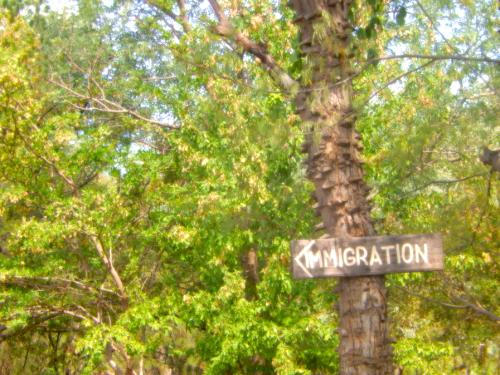
On first arriving at the immigration post we found nobody at home at all: just a friendly yellow dog. Eventually a lady with her baby came out to stamp our passports, and we headed back down the dirt track to find our boat for the next few nights, the Zambesi Queen:
The Zambesi Queen has something of the look of a Mississippi riverboat as it glides gently along. The cabins are spacious, and everything is set up beautifully for spotting the endless parade of wildlife and exotic birds:
At this point in our journey the mood changed and relaxed somewhat. In my first lecture I had contrasted Nadine Gordimer as a Johannesburg writer to J.M. Coetzee as a Cape Town writer, and we had considered Gordimer’s last novel No Time Like the Present as, in part, a gently satirical commentary on Coetzee’s decision to abandon South Africa for Australia. Our experience of each city helped us to understand the tensions explored in this her last novel, written in her late eighties. On board the Queen, however, we considered the more relaxed topic of Botswana as an African success story. The alums were so relaxed that before my lecture the ladies disappeared behind the screen of my Powerpoint, onto the rear deck, to celebrate the buying of new jewellery with a collective photograph. Once returned, however, they responded with comments as sharp and incisive as ever. I was able to enter into this newly relaxed mood on returning to my cabin, with its own outside balcony. This must rate as my best workplace ever; sunsets were Cecil B. de Spectacular:
From the first, next day, birds and animals began presenting themselves in ever more spectacular postures:
We travelled both by the Queen and in smaller vessels that enabled us to nose our way into private parts of the river. Here we approach hippo parents with baby:
And here we realize, just in time, that Daddy Hippo is giving us the eye– by way of saying, back off:
A carmine bee-eater appeared on one bank, and an African fish eagle on the other:

We switched to smaller craft to cruise the Chobe river, and to visit Kasenu village. Some sixty people live here, all from one family. In earlier generations the elders would select a marriage partner from a neighboring village, but nowadays the young people are free to choose for themselves. Trees are of great importance here: we saw an aphrodisiac tree, an abortion tree, and a tree to shade the chief of the village. We also saw a TV satellite dish: the African Cup of Nations soccer competition was being followed everywhere during our trip.
Victor, grandson of the chief, explained how things work to Lise and Tom Elkind (C 73):
We set out on further wildlife adventuring, and I decided that for me nothing is more exciting and moving than seeing long lines of elephants on their slow and stately way, like a people of the plains:
It was also wonderful to see them come down to the water, and to water themselves, and then frolic and play. They arrive grey, get black when wet, then throw mud over themselves:
One fears for the little ones, of course, because not every creature at the water’s edge is a benign herbivore:
Our last night on the Zambesi Queen opened with a locally-produced feast, and the singing of the Namibian national anthem:
The capo Wayne is South African, but all the rest of the crew is Namibian. The company sent Wayne’s deputy, John, a Namibian local, to study for his pilot’s license, and he is set to succeed Wayne shortly. The crew work one week on, one week off, and seem happy with their life and work. They initiated some round-the-table dancing towards the end of the evening, and then persuaded some distinguished Penn alums to join them. Photos are available from me, by private application and for a large fee.
Early next day we left the Zambesi Queen and Namibia for a game drive in Chobe National Park, Botswana. It was now Friday 13th February, but all went well– and by now, we had quite lost track of days of the week. In fact, the absence of wifi on the Queen was one of its more relaxing aspects, coupled with its gently swaying up and down the river on its mooring at night. Most of us had taken malaria pills, but insects were never a serious issue, and the hardy Tina (who took no pills) simply doused herself with insect-repellent lotion and slept with her balcony door open– so that she could hear the amorous bellowings of hippos by night.
We first thought that a dry game drive might be an anti-climax after our animal sightings by water, but this was not the case: we saw some animals, such as elephants, from different perspectives and some from much closer quarters than before. Giraffes, for example:
When elephants blocked the way of our safari buggy, we graciously gave way– you can see that the camera work here was a tad shaky:
Impala, unlike mad dogs and Englishmen, had the sense to hide from the mid-day sun:
Finally we caught up with our bus and our luggage, decanted ourselves inside, and then headed for the Zimbabwe border. This, we thought, might be our trickiest transfer, and there was indeed quite a long tail-back of lorries and busses at the border. But we sailed to the front of the line, and were through very quickly (although the wait seemed long). We were briefed to put on our seat belts, and to take no pictures of any police stopping points that we might see. But we were never stopped, and were soon heading deep into Zimbabwe. Our driver made the correct right turn at just the right moment:
The Victoria Falls Hotel, set in extensive grounds, turned out to be yet one more glorious monument to English colonial style, c. 1900-1930:
The mosquito net in my bedroom was not needed, but it added an exotic touch; warthogs and monkeys could be seen frolicking on the lawn below: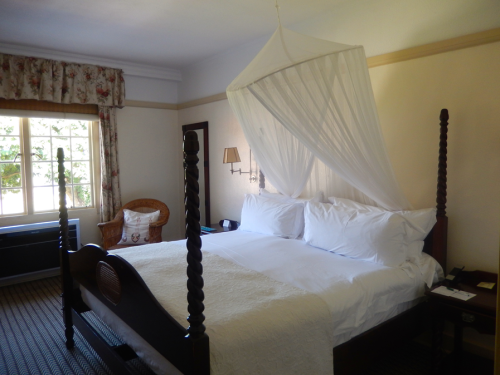
Valentine’s Day saw us heading out to the vast body of water, a mile across, a million gallons a second, known as Mosi-Oa-Tunya (but renamed Victoria Falls by Dr David Livingstone in 1855). Vellon Phiri, our local Zimbabwean guide, was happy to give us pronunciation lessons, and then to pose beneath Livingstone’s massive statue:
Equipped with poncho style black raingear, like a strange order of monks, we processed to the Falls:
Spray from the thunderous falls, which can be seen from far away, has created a tropical micro-climate in which delicate plants flourish:
Veterinarians Judy Shekmar and Steve Cantner (V 76), who have owned and run the Bryn Mawr Veterinary Hospital for more than thirty years, went ape went spotting vervet monkeys by the Falls:
Before leaving the Falls the Penn alums posed in their wetgear for one last photo; the banner here is held by Judy Shekmar and Betsy Kleeblatt (CW 68):

Before returning to the hotel we stopped off at a local market. Traders were never forceful, but they were keen to relieve us of our cash and, failing that, of our socks and hats. There are reports of one visitor returning to the hotel almost naked, with a bag full of wooden bowls and statutes. I held onto my Alumni cap but, next day, donated my Phillies cap– perhaps someone else wearing it will bring us better luck:
Back at the hotel the Penn group scrubbed up nice and presented itself for our Penn alumni wine reception:
This convivial drinks party immediately preceded Roberto Delgado’s second lecture on bio-diversity in the region, and on what we can all do to help protect the environment. Clear-cutting to produce Palm Oil leads to extensive deforestation of virgin rain forest, he told us, so Honey Nut Cheerios and Dove soap are now off the menu. Finally, the day ended with (another) sumptuous dinner. Next day the group flew from Victoria Falls airport to Johannesburg, and from there we went our separate ways. The main group of alums headed to the MalaMala game reserve, and I flew back to London to continue my sabbatical. The birdlife that I have found here so far has been far from exotic:
But I am warmed by the memory of the wonderful friendships so quickly formed among our intrepid group of sixteen. And I realize that in a sense your life can be divided between the time before you saw elephants, moving majestically across their natural terrain, and after that moment. And happily, like elephants, we will never forget.

To learn more about Penn Alumni Travel visit our website at: http://www.alumni.upenn.edu/travel .














